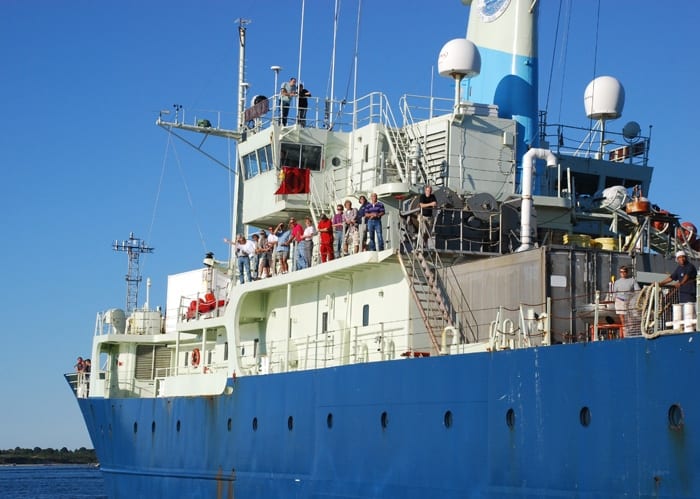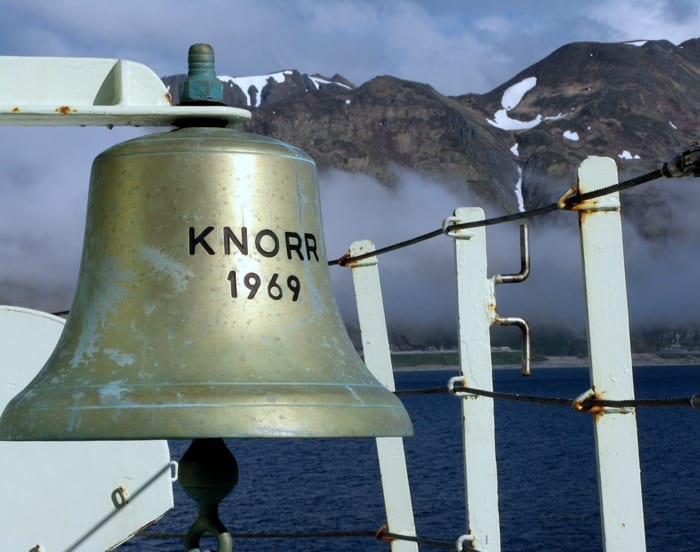WHOI Hosts Tours of the Research Vessel Knorr
August 1, 2011
On Sunday, August 7, from 11 a.m. to 3 p.m., the Woods Hole Oceanographic Institution (WHOI) will host a free community event featuring a rare opportunity to tour the oceanographic research vessel Knorr. The ship is best known as the one used in the discovery of the wreck of the Titanic and of the first hydrothermal vents. Visitors to the event will also be able to attend talks by one of Knorr’s former captains and scientists who have used it to study the world’s ocean.
Ship visitors will also be able to hear from scientists and technicians preparing to depart for a research cruise off Iceland aboard Knorr about what it’s like to do scientific research aboard a research vessel and will see up close some of the equipment used to conduct oceanographic research. Among those visitors will hear from will be WHOI paleo-geologist Bill Curry, who will describe the ship’s “long corer,” a unique system that enables researchers to extract 150 foot-long sediment cores from the seafloor for use in their studies of Earth’s climate. Ship’s crew will also be on hand to describe their daily life on the ship that is their home and their role in helping scientists achieve their research goals in all kinds of weather and in locations that span the globe.
Tours leave from the WHOI dock from 11 a.m. to 3 p.m., with the last tour beginning at 2:15 p.m. Entrance to the WHOI dock is through the gate at 86 Water Street, Woods Hole. The tour will take visitors to four of the ship’s decks, including lab spaces, living quarters, and bridge. Those visiting the ship should wear comfortable shoes and must be able to climb ladders. Visitors must have a valid ID, and children must be escorted by an adult. Due to port security restrictions, backpacks and other bags will not be allowed.
The presentations will be held in Redfield Auditorium at 12 p.m. and 2 p.m. and will highlight the ship’s important role in the history of ocean exploration. Speakers include:
- Susan Avery, WHOI President and Director, who will give a brief welcome and introductory remarks.
- A.D. Colburn, captain of the R/V Atlantis, who will share some stories from his time as captain of the Knorr.
- Dave Gallo, WHOI vice president of special projects, who will talk about how in 1985 a team led by WHOI and French colleagues, working from the Knorr, discovered the wreck of the Titanic, and how research and exploration of the wreck continues today.
- Susan Humphris, a WHOI geologist, who will describe the 1977 discovery of communities of deep-sea creatures living at hydrothermal vent sites by scientists working aboard the R/V Knorr at the Galapagos Rift, a discovery that transformed our understanding of life on Earth and spawned entirely new lines of multidisciplinary research.
The talks will also be streamed live on the Internet at https://www.whoi.edu/administration/development/knorrTour/.
A global class research vessel owned by the Navy and operated by WHOI, Knorr was delivered to Woods Hole in 1970, and has since traveled more than a million miles—the equivalent of two round trips to the Moon or forty trips around the Earth. The ship’s anti-roll tanks and ice-strengthened bow enable it to work in all of the world’s oceans and to the edges of the Polar Regions. The ship can carry a crew of 22 and a scientific party of 32 to sea for as long as 60 days to conduct some of the most advanced ocean-going scientific research possible.
As part of this event, the WHOI Ocean Science Exhibit Center will be open Sunday from 10 a.m. to 4 p.m., with exhibits highlighting the technology used to find the Titanic and displays and spectacular high-definition video footage of hydrothermal vents.
For more information about the “Tour the Knorr” event, please call 508-289-2252 or visit the event website at https://www.whoi.edu/administration/development/knorrTour/.
The Woods Hole Oceanographic Institution is a private, independent organization in Falmouth, Mass., dedicated to marine research, engineering, and higher education. Established in 1930 on a recommendation from the National Academy of Sciences, its primary mission is to understand the ocean and its interaction with the Earth as a whole, and to communicate a basic understanding of the ocean’s role in the changing global environment.


